QLC Considerations for Mainstream Adoption
How QLC SSDs can lower costs and improve outcomes for broader data center storage


In response to the ever-increasing demand for data storage, characterized by exponential growth and the necessity for more economical and higher-density storage solutions, flash technology has progressed from 2D to 3D architecture, from tens of layers to several hundred, and from SLC and MLC to TLC, QLC, and even PLC.
As of now, 3D TLC NAND stands as the predominant flash NAND technology, while 3D QLC NAND is steadily gaining traction as it evolves and garners greater acceptance from consumers and an expanding ecosystem. QLC-based SSDs offer unmatched levels of environmental sustainability, scalability, cost-effectiveness, and storage capacity when compared to available alternatives in the market.
This article delves into the reasons behind the continued growth in demand for QLC technology, while also providing a comprehensive comparison of QLC SSDs with established storage device options. This comparison is intended to equip data center architects with the knowledge required to make optimal choices for their storage needs. But before we embark on the exploration of QLC's readiness for mainstream acceptance, we will commence with a brief overview of QLC definitions and industry standards.
What is QLC
QLC stands for quad-level cell where each NAND cell stores four bits of data. As the number indicates, this extra bit allows for higher density than triple-level cell (TLC), the most common NAND flash shipped today. That fourth bit translates to an instant 33% increase in areal density and a roughly 25% dollar-per-gigabyte cost savings, (not taking into account other cost savings at the SSD level, such as less DRAM with coarse IU). With this advantage, Solidigm's 192L QLC areal density (18.6 Gb/mm sq) is much greater than comparable TLC NAND SSDs, even with fewer layers. [1]
To store four bits, the QLC cell needs to write and read 16 voltage levels, twice that of TLC, which does lead to a relatively lower P/E cycle and I/O speed than TLC at the NAND level.
However, SSD performance and endurance are influenced by a multitude of factors at the drive level. These encompass the I/O interface speed, firmware optimization and tuning, overprovisioning, as well as controller and channel configurations, all of which complement the inherent characteristics of NAND component alone.
Furthermore, beyond the NAND component itself, the quality and reliability of SSDs are heavily reliant on the operational environment, the overall resilience and integrity of firmware and hardware across a diverse range of applications, the precision of the manufacturing process, and the effectiveness of data protection mechanisms.
We will use Solidigm QLC SSDs as an example to illustrate the level of performance and reliability QLC drives can achieve later in the article. Solidigm QLC NAND has undergone four generations of development since its initial introduction in 2017, resulting in significant enhancements in endurance, performance, and density, as illustrated below.
In the upcoming sections of this article, we will utilize Solidigm QLC SSDs as an example to showcase the impressive performance and reliability that QLC drives can attain. The Solidigm QLC NAND technology has evolved through four generations of development since its inception in 2017, leading to substantial improvements in terms of endurance, performance, and storage density.
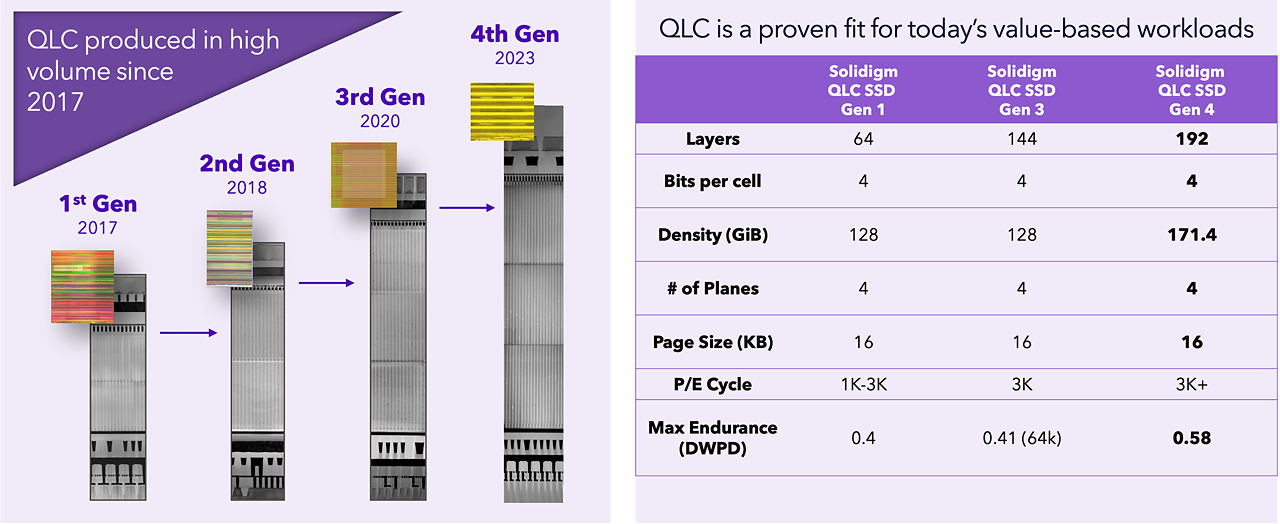
Figure 1. Solidigm QLC NAND evolution
In the upcoming sections of this article, we will utilize Solidigm QLC SSDs as an example to showcase the impressive performance and reliability that QLC drives can attain. The Solidigm QLC NAND technology has evolved through four generations of development since its inception in 2017, leading to substantial improvements in terms of endurance, performance, and storage density.
How is QLC ready for mainstream adoption?
As we analyze QLC’s readiness for mainstream, we will focus on four key aspects: vendor readiness, data access pattern alignment, ecosystem, and cost. Let’s take a look at each of these now.
Vendor readiness
Leading NAND and SSD manufacturers have already commenced mass production of QLC-based NAND and QLC SSDs for both client and enterprise. Notably, Forward Insights has forecasted that QLC's market share will grow to 30% by 2025. [2] As a prime example, Solidigm has already advanced to its third generation of datacenter QLC SSDs. This latest generation of QLC NAND exhibits an impressive P/E cycle of over 3K, coupled with an impressive drive endurance reaching as high as 0.58 drive writes per day (DWPD). The persistent commitment to investment and ongoing enhancements of the QLC technology across the industry serves as the linchpin for the continued growth of QLC.
Data access pattern alignment
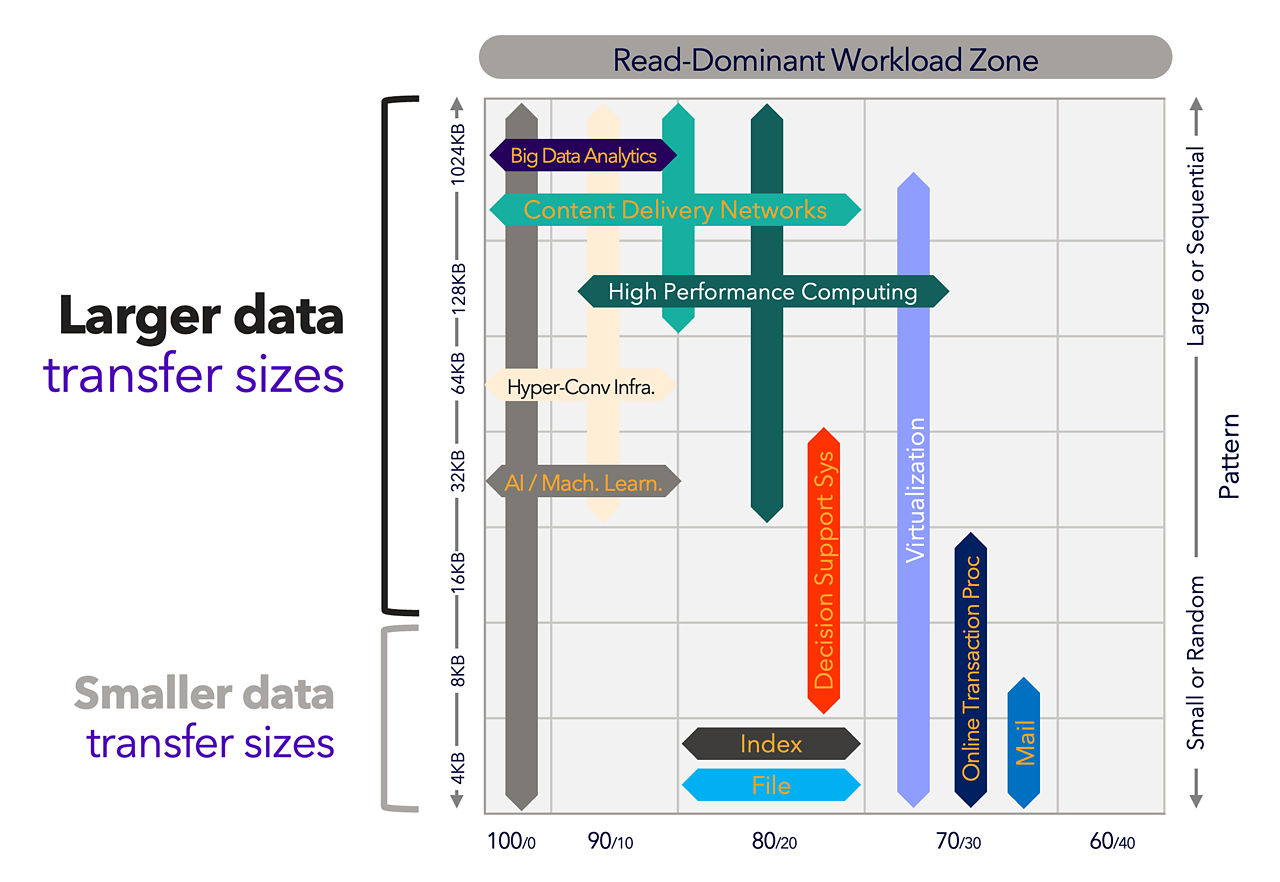
Figure 2. Data center workloads
In today's data centers, the predominant workload consists of read-intensive operations with larger data transfer sizes. Storage architects place a greater emphasis on designing systems that facilitate quicker and more consistent data read access at a reduced cost. Concurrently, file systems and storage engines shape write IOs to optimize performance, effectively maximizing write bandwidth and prolonging the life of flash drives. Additionally, as drive capacity increases, the requirement for drive endurance, as indicated by the DWPD (drive writes per day) rating, decreases for the same Petabytes Written (PBW).

Figure 3. Discoveries regarding endurance from multiple studies
Hence, QLC SSDs emerge as the superior choice, providing ample drive capacity and cost-efficiency without compromise on performance. Taking the Solidigm D5-P5336 series as an example, it exhibits read bandwidth on par with mainstream PCIe 4.0 TLC-based SSDs and boasts a maximum Petabytes Written (PBW) that surpasses even the highest capacity TLC-based SSDs.

Table 1. QLC SSDs performance and endurance comparison to TLC SSDs
Backed by the performance of Solidigm D5-P5536, QLC flash proves to be a highly suitable choice, generating significant value for non-random-write-intensive use cases. It not only lowers OPEX (Operational Expenditure) but also elevates both IO/GB and IO/$ metrics compared to traditional SATA/SAS hard disk drives and slashes CAPEX (Capital Expenditure) costs when contrasted with TLC alternatives without any noticeable compromise in performance.
Ecosystem
Storage hardware and software providers have proactively developed solutions and services tailored to QLC technology. Companies like VAST Data, Dell Powerscale, Pure Storage, IBM, DDN, NetApp, and many others have integrated QLC-based applications into their offerings.
Moreover, numerous cloud service providers, including Alibaba, have already embraced QLC in services like Elastic Compute Service (ECS) for big data local disk instances. When QLC is deployed to replace short-stroked HDDs, it results in marked improvements across performance, capacity, latency, and the total cost of ownership (TCO).
As these pioneering companies continue to lead the way in innovation and achieve greater success, more diverse use cases will emerge, attracting a wider group of adopters to follow suit.
Cost
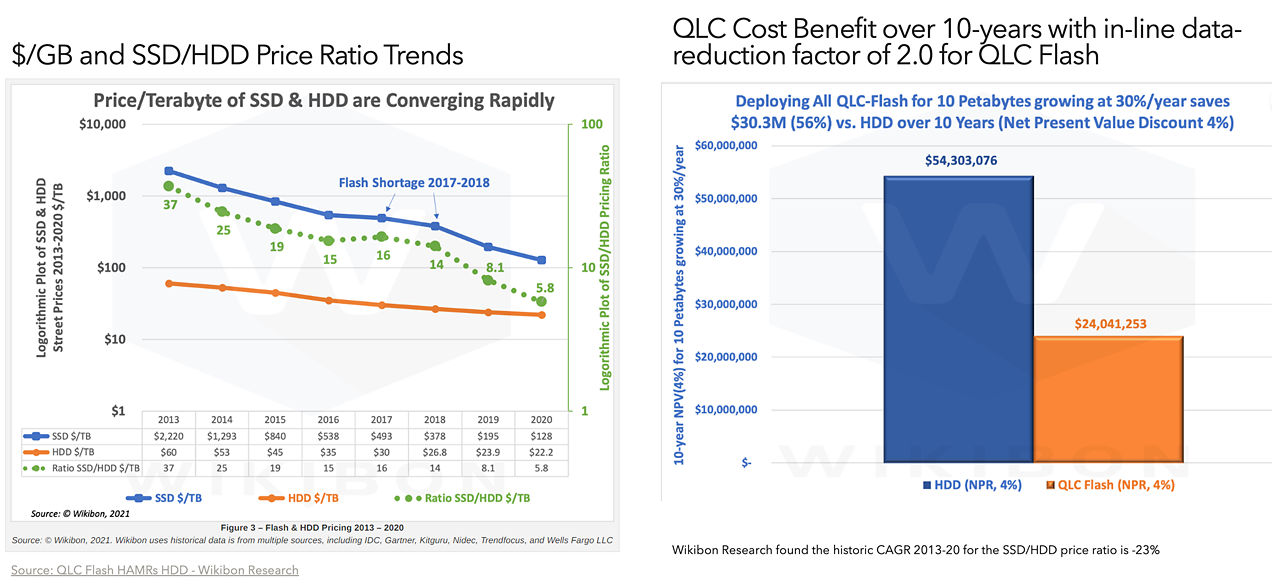
Figure 4. Raw cost per GB trends and QLC cost benefits over 10 years
With the accelerated decline in flash prices compared to HDDs, the gap between the price-per-gigabyte of HDDs and flash storage is rapidly narrowing. This ongoing trend is expected to accelerate the adoption of flash technology, particularly QLC flash, thanks to its exceptional total cost of ownership (TCO) benefits driven by its ultra-high areal density.
In support of this, a TCO analysis conducted by Wikibon Research has revealed substantial savings, amounting to $30.3 million, over a 10-year period for a 10PB cluster, in comparison to traditional HDD solutions. [8]
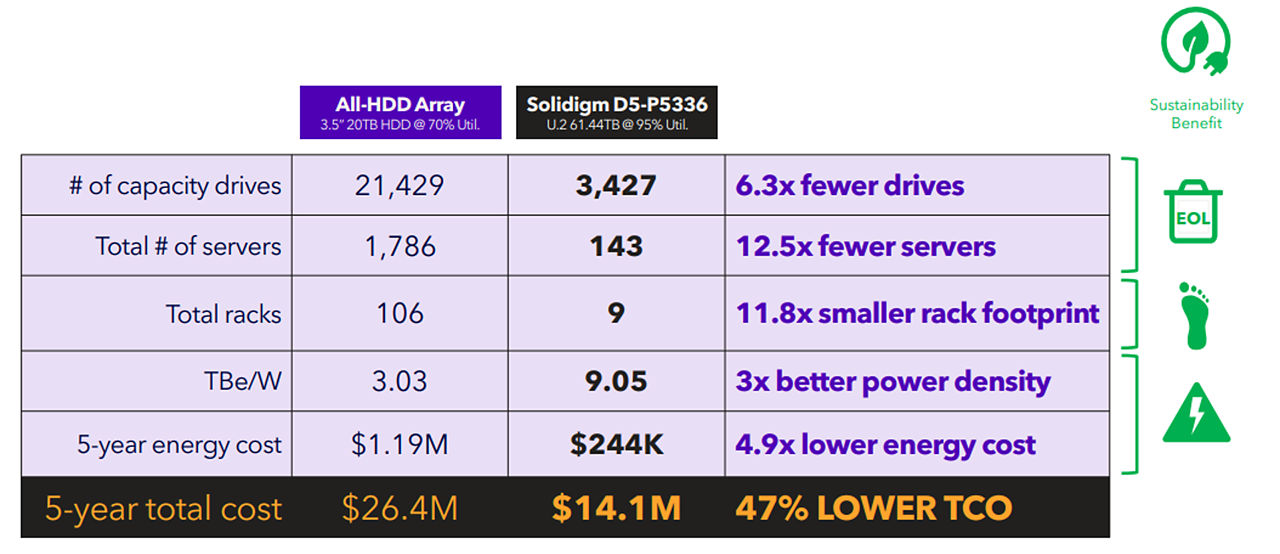
Table 2. TCO value when solving for 100PB object storage cluster
We present a TCO cost-benefit analysis demonstrating an impressive 47% TCO saving when comparing QLC to HDD over a five-year span. [9] These savings encompass reductions in rack space, energy consumption, labor costs, and the added advantage of a significantly reduced end-of-life disposal footprint, contributing to enhanced sustainability.
Solidigm is poised to bring QLC to the mainstream
The transition to any new technology is a gradual process, and Forward Insight projects that the industry is increasingly embracing QLC. Market trends indicate a shift from early adopters towards the early majority, signifying growing acceptance.
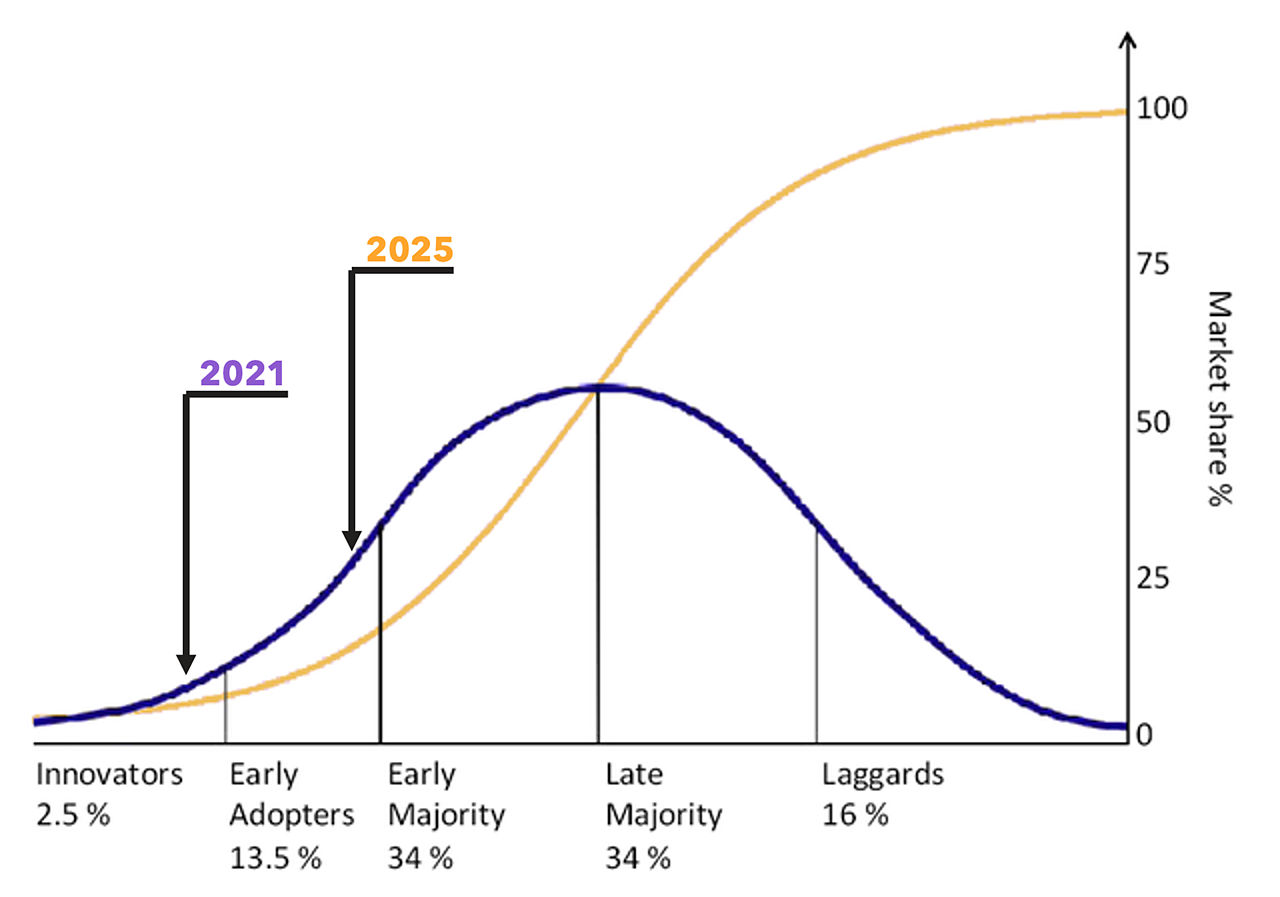
Figure 5. Expansion of QLC market into mainstream
Solidigm, a pioneer and leader in QLC storage solutions, boasts the expertise and experience needed to build high-quality products that precisely align with end users' demands for reliability, endurance, and performance. After years of dedicated product refinement, Solidigm's data center QLC SSDs have demonstrated a remarkable rolling Annual Failure Rate (AFR) as low as 0.1%. [10]
QLC-based solutions are already making headway, displacing performance and nearline (NL) HDDs, as well as TLC-based SSDs in various applications such as active archives, large-scale NAS, software-defined scale-out storage, cloud environments, and virtual setups. Wider adoption is clearly on the horizon.
Final thoughts
Although QLC by itself may not overtake the whole market share, it is likely to expand into the mainstream in the near future. Some of the motivators include:
New storage standards such as zoned namespace (ZNS) and flexible data placement (FDP)
Software and filesystem support on coarse IO blocks and high-density clusters
Complementary products such as SLC SSDs, computational or acceleration software and hardware that boost the performance and elongate the endurance of QLC
Cost savings on QLC NAND production resulting from economies of scale
Notes
[2] http://www.forward-insights.com/reportslist.html
[3] Solidigm. D5-P5336 product specifications and current 5 quarter roadmap. Max endurance for D5-P5336 based on 100% 16K RW @ 61.44TB capacity.
[4] Samsung. Performance and PBW from highest capacity drive available. https://image.semiconductor.samsung.com/resources/data-sheet/Samsung_SSD_PM9A3_Data_Sheet_Rev1.0.pdf
[5] Micron. Performance and PBW from highest capacity drive available. https://media-www.micron.com/-/media/client/global/documents/products/product-flyer/7450_nvme_ssd_product_brief.pdf
[6] Micron. Performance and PBW detailed at https://www.micron.com/products/ssd/product-lines/6500-ion
[7] Kioxia. Performance and PBW from highest capacity drive available. https://americas.kioxia.com/content/dam/kioxia/shared/business/ssd/data-center-ssd/asset/productbrief/dSSD-CD8-R-U2-product-brief.pdf
[8] http://wikibon.org/wiki/v/Calculating_Infrastructure_TCO_per_VM
[10] Solidigm QRE Team internal tracking
About the Author
Yuyang Sun, Senior Manager of Product Marketing at Solidigm, has over a decade of experience in SSD storage design, business planning, marketing, and strategy. Her day-to-day interactions with major industry players have allowed her to gain invaluable insights into the world of data center storage solutions, and she has been actively involved in managing data center QLC SSD products since their inception. Yuyang holds a Bachelor's and Master's degree in Electrical Engineering from UBC and an MBA from the Wharton School of Business. In her leisure time, she enjoys playing badminton and even co-founded a local badminton club with hundreds of active members.